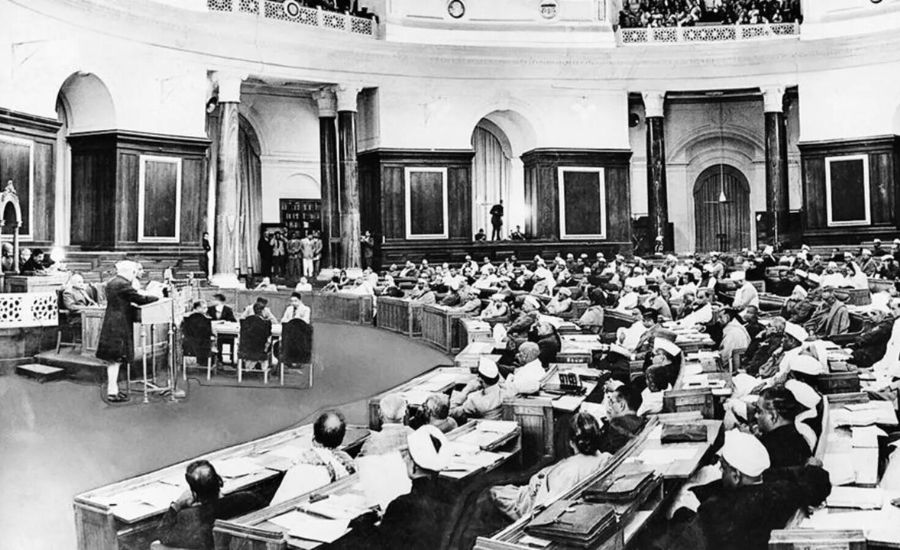
On 29 August 1947, Satyanarayan Sinha moved a motion in the Constituent Assembly to appoint a Drafting Committee ‘to scrutinise and to suggest necessary amendment to the draft Constitution of India prepared in the Office of the Assembly on the basis of the decisions taken in, the Assembly’. This Drafting Committee would comprise the following members: Alladi Krishnaswami Ayyar, N. Gopalaswami Ayyangar; B.R. Ambedkar, K.M Munshi, Mohammed Saadulla, B.L. Mitter and D.P. Khaitan.

Assembly members didn’t seem to have any problem with the membership of the Drafting Committee. The proposed members were rather well-regarded individuals with extensive legal experience in the legal field. However, there were concerns about the timing of the appointment of the Committee and its role in the constitution-making process. The first time this was brought up, was in B.G. Kher’s amendment that proposed to replace Sinha’s motion to make it more specific. It stated:
‘to scrutinise the draft of the text of the Constitution of India prepared by the Constitutional Adviser giving effect to the decisions taken already in the Assembly and including all matters which are ancillary thereto or which have to be provided in such a Constitution, and to submit to the Assembly, for consideration the text of the draft Constitution as revised by the Committee.’
The difference between Kher’s amendment and Sinha’s original motion reflects a certain tension that played out in the discussion that followed. The power of the Drafting Committee to ‘suggest’ changes to the draft prepared by the Advisor in Sinha’s version implied that the Drafting Committee could, on its own (without Assembly’s approval), take a view on a matter related to the Constitution. Kher’s version emphasised that the Drafting Committee was merely going to put into constitutional form the decisions of the Assembly and resubmit it to the Assembly for final consideration.
Sinha accepted Kher’s version, but these tensions were not resolved and Assembly members raised two sets of issues. First, members feared that the timing for the appointment of a Drafting Committee wasn’t appropriate. Jaipal Singh argued that ‘…a great many important subjects are yet left over. They have not been decided by this Assembly and I don’t see how we can delegate our constitution making power to any Committee at all..’. Singh along with few other members wanted the Drafting Committee to be appointed after all aspects of the Constitution were first debated by the Assembly. This would ensure that the Drafting Committee was implementing the Assembly’s decisions and not taking its own stances on various subjects.
The second issue was regarding decisions already taken by the Assembly. After the Drafting Committee transformed them into specific Articles and clauses – would these then be set in stone? And not open to further debate and changes by the Assembly?
The primary concern that was at the heart of these two sets of issues was the relationship between the Drafting Committee and the Assembly as a whole. Assembly members wanted to limit the powers of the Drafting Committee and make it subservient to the Constituent Assembly.
Sinha clarified to the Assembly that ultimate authority lay with the Constituent Assembly – he stated that ‘the Drafting Committee’s Report will be before this House and this House has got an inherent right to alter, modify and change anything it likes. I think the Assembly has the right to change even the decisions.’ That said, he added that it ‘will not be fair if it [Assembly] goes on changing the decision which it has once taken and therefore I think the House will not agree to change the decisions on important principles which were discussed and decisions arrived at’. The President of the Assembly too chimed in and spoke in a similar vein to Sinha and assured members that real power was with the Assembly and not the Drafting Committee.
Members of the Assembly seemed convinced and they adopted the motion as amended by Kher.
This debate on the powers of the Drafting Committee and its role in the larger constitution-making process sprung up quite a few times in subsequent Assembly debates. The Committee faced allegations that it had included something that the Assembly had not aproved. For example, during the discussion on affirmative action, Thakur Das Bhargav remarked that the Drafting Committee had gone beyond its scope in making amendments to the Draft Constitution without the Assembly’s approval.
